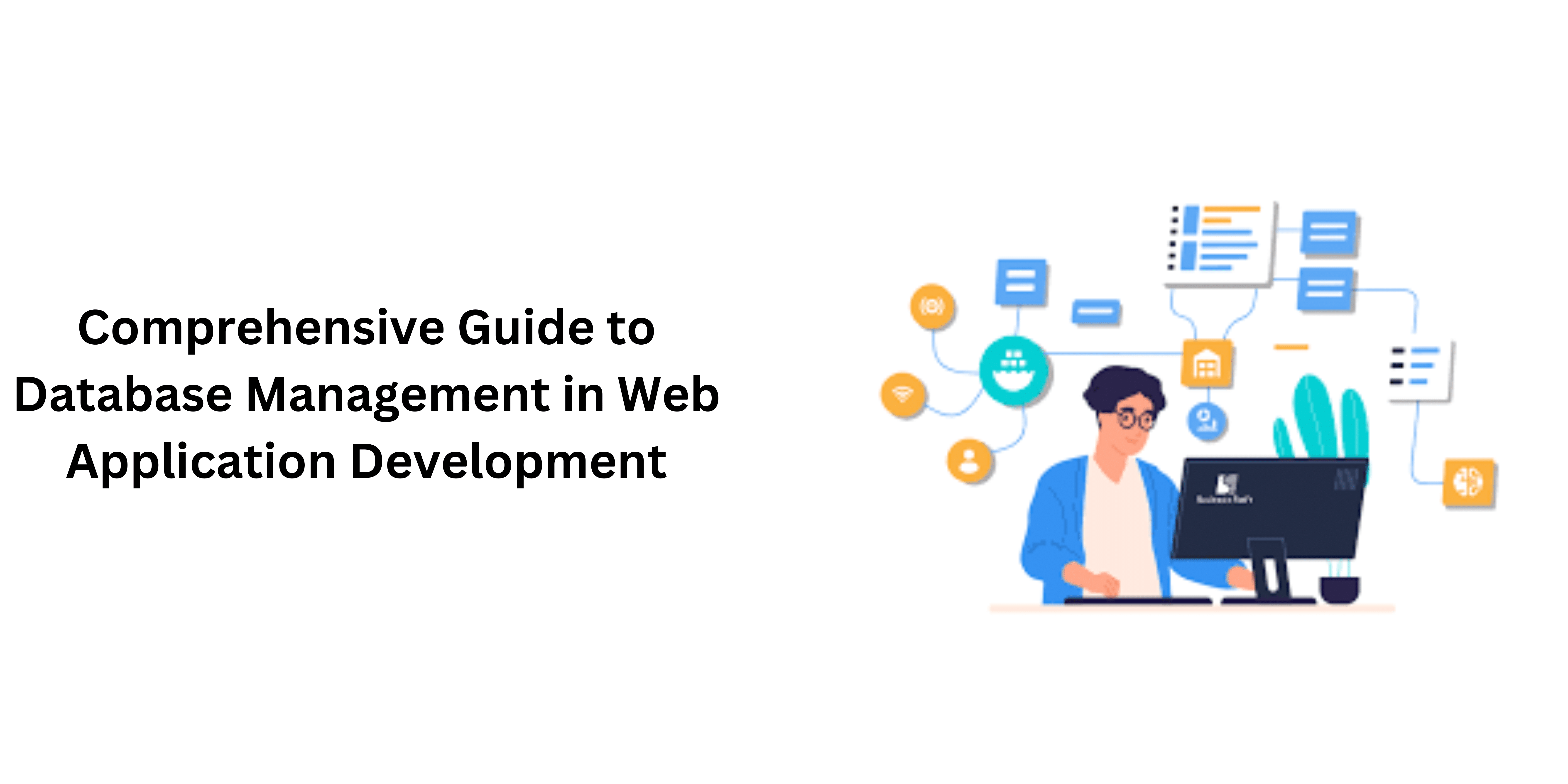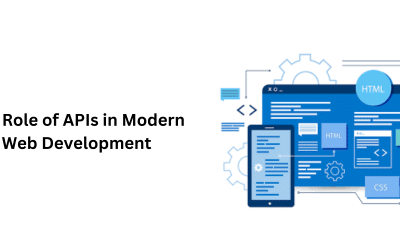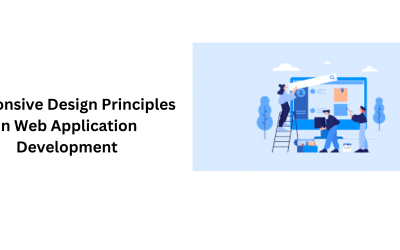In the realm of web application development, effective Database Management stands as a cornerstone for the seamless functioning and success of digital platforms. The dynamism and complexity of modern web applications necessitate robust systems for storing, organizing, and retrieving data. This introduction serves as a gateway to explore the intricate world of Database Management in the context of web development.
web and mobile applications rely on databases to store, manage, and retrieve vast amounts of information in a structured and efficient manner. Whether it’s e-commerce platforms, social networking sites, or content management systems, the underlying database architecture plays a pivotal role in ensuring data integrity, accessibility, and security.
As technology evolves, so do the approaches to database management, with a growing emphasis on scalability, real-time processing, and integration with cloud-based solutions. This overview sets the stage for a comprehensive exploration of the various facets involved in effectively managing databases within the dynamic landscape of web application development.
Importance of Database Management for Web Applications
Database Management holds paramount importance in the realm of web applications, serving as the foundational infrastructure that underpins their functionality and performance. At the core of this significance lies the need for efficient data storage, retrieval, and manipulation, essential for the dynamic and interactive nature of web platforms. Web applications, ranging from e-commerce sites to social networks, rely on databases to store vast volumes of information, including user data, content, and system configurations.
The systematic organization of this data through database software management ensures data integrity, minimizing errors and inconsistencies. Moreover, effective database management facilitates rapid and precise data retrieval, contributing directly to enhanced user experiences.
Security is another critical dimension of importance, as databases store sensitive user information. Robust database management systems implement security measures such as encryption, access controls, and authentication protocols to safeguard against unauthorized access and data breaches. The scalability of web applications is also intricately tied to database management, allowing platforms to grow seamlessly as user bases expand. Real-time data processing, a growing necessity in contemporary web applications, is made possible through efficient database management, enabling timely updates and responses to user interactions.
Furthermore, as web development increasingly embraces cloud-based solutions, database management becomes instrumental in facilitating the seamless integration of applications with scalable and flexible cloud databases. In essence, the importance of database management for web applications extends beyond mere data storage; it is a linchpin for ensuring reliability, security, scalability, and responsiveness in the ever-evolving landscape of web development.
Types of Databases Used in Web Development
In the multifaceted realm of web development, various types of databases play pivotal roles in managing and organizing data efficiently. One prevalent category is Relational Databases, exemplified by MySQL, PostgreSQL, and Microsoft SQL Server. These databases organize data into tables with predefined relationships, adhering to a structured schema, making them suitable for applications where data integrity is crucial.
Contrasting this, NoSQL databases, including MongoDB, Cassandra, and Redis, offer a more flexible approach. NoSQL databases can handle unstructured or semi-structured data, making them adept at managing diverse data types often encountered in dynamic web applications. Graph databases, such as Neo4j, specialize in representing and traversing relationships between data points, making them ideal for applications with complex interconnections, such as social networks. Another significant category is Time-Series Databases, like InfluxDB, tailored for handling data points indexed by time, commonly used in applications requiring chronological analysis, such as IoT devices and monitoring systems.
Additionally, NewSQL databases aim to combine the best of both relational and NoSQL databases, providing scalability while maintaining ACID compliance. The choice of database type in web development is contingent upon the specific requirements of the application, including factors like data structure, scalability needs, and the nature of relationships between data points. This diversity in database types underscores the adaptability of web development to a spectrum of data management needs, allowing developers to select the most fitting solution for their project’s unique demands.
Relational Databases and their Role in Web Applications
Relational databases play a foundational and indispensable role in the landscape of web applications development, providing a structured and organized framework for managing data. Examples of widely used relational database management systems (RDBMS) include MySQL, PostgreSQL, and Microsoft SQL Server. In the context of web development, these databases are characterized by their ability to store and retrieve data in structured tables with predefined relationships, adhering to a well-defined schema.
This structured approach ensures data integrity, as it enforces rules on how data is entered and related, reducing the likelihood of errors and inconsistencies. The normalization process, a key aspect of relational database design, further enhances data integrity by minimizing redundancy and optimizing storage efficiency.
Relational databases are particularly well-suited for web applications that require complex querying, reporting, and transactions. They excel in scenarios where the relationships between different data entities are crucial, such as in e-commerce platforms handling inventory, customer, and order data. The structured nature of relational databases simplifies the execution of SQL queries, allowing developers to retrieve and manipulate data with precision.
Additionally, relational databases support the implementation of ACID (Atomicity, Consistency, Isolation, Durability) properties, ensuring the reliability and robustness of transactions, which is critical for applications that involve financial transactions or sensitive user information. Overall, the role of relational databases in web applications extends beyond mere data storage; they provide a robust and organized foundation that enables developers to build scalable, secure, and highly functional web platforms.
NoSQL Databases: A Contemporary Approach in Web Development
NoSQL databases represent a contemporary and flexible approach to data management in web development, challenging the structured constraints of traditional relational databases. Unlike their relational counterparts, NoSQL databases embrace a schema-less design, accommodating diverse and unstructured data types commonly encountered in dynamic web applications. Examples of popular NoSQL databases include MongoDB, Cassandra, and Redis. One of the primary advantages of NoSQL databases is their ability to scale horizontally, making them well-suited for applications with fluctuating workloads and large amounts of data.
These databases software is particularly adept at handling the vast and varied datasets prevalent in modern web applications, including social media platforms, content management systems, and IoT applications. NoSQL databases are categorized into different types, such as document-oriented, key-value stores, column-family stores, and graph databases, each tailored to specific data storage and retrieval requirements.
Document-oriented NoSQL databases, like MongoDB, store data in flexible, JSON-like documents, facilitating seamless storage and retrieval of complex data structures. Key-value stores, such as Redis, excel in high-speed data access by associating unique keys with corresponding values.
Column-family stores, like Apache Cassandra, organize data in columns rather than rows, optimizing for query speed and scalability. Graph databases, exemplified by Neo4j, specialize in representing and traversing relationships between data points, making them ideal for applications with intricate interconnections. The rise of NoSQL databases underscores the evolving nature of web development, where adaptability and scalability are paramount, allowing developers to choose database solutions that align with the specific requirements and dynamics of their projects.
Key Concepts in Database Design for Web Applications
Database design for web applications is a crucial process that involves several key concepts aimed at ensuring efficiency, data integrity, and optimal performance. The fundamental concept is the identification and organization of entities, representing real-world objects or concepts, into tables. Each table consists of attributes that define the properties of the entities, forming the basis of a structured database schema. Relationships between tables are established through keys, such as primary keys and foreign keys, facilitating the linking of related data across different tables.
The concept of normalization is integral to database design, involving the elimination of data redundancy by organizing tables to minimize duplication and dependency. This process enhances data integrity and reduces the likelihood of anomalies during data manipulation. Another critical aspect is indexing, which involves creating indexes on specific columns to expedite data retrieval, particularly in large datasets. The choice of appropriate data types for each attribute is essential, optimizing storage space and ensuring accurate representation of the data.
Additionally, the concept of transactions plays a vital role, emphasizing the grouping of database operations to ensure either all or none of the changes are applied, maintaining the consistency of the data. Database designers also consider constraints, such as unique constraints and check constraints, to enforce rules on data entries, preventing the violation of integrity rules.
Finally, the concept of denormalization may be employed in certain scenarios to improve query performance by reintroducing redundancy, striking a balance between data integrity and performance. Overall, the effective application of these key concepts in database design lays the groundwork for robust, scalable, and well-performing web applications.
Data Modeling for Web Application Databases
Data modeling is a fundamental aspect of designing web application databases, serving as the conceptual blueprint that outlines the structure, relationships, and rules governing the storage and retrieval of data. The process involves transforming real-world entities and their relationships into a structured representation within the database. Entity-Relationship Diagrams (ERDs) are commonly employed as visual tools to depict these relationships, showcasing entities as tables and relationships as lines connecting them. During data modeling, careful consideration is given to defining primary keys, unique identifiers for each record, and foreign keys, establishing links between related tables.
The normalization process, an integral part of data modeling, aims to minimize redundancy and dependency within the database by organizing tables into normalized forms. Normalization enhances data integrity, reducing the risk of anomalies during data manipulation. Data modeling also involves choosing appropriate data types for each attribute, optimizing storage efficiency and ensuring accurate representation of the data.
Furthermore, data modeling incorporates the consideration of cardinality, defining the numerical relationships between associated entities, whether one-to-one, one-to-many, or many-to-many. This understanding is crucial for determining the structure of tables and the nature of relationships between them.
As web applications evolve and requirements change, an agile approach to data modeling allows for adjustments to the database structure, ensuring it remains aligned with the dynamic needs of the application. In essence, effective data modeling in web application databases is the cornerstone for creating well-organized, scalable, and maintainable databases that form the backbone of robust and efficient web platforms.
Structured Query Language (SQL) and its Significance
Structured Query Language (SQL) stands as the universal language for interacting with and managing relational databases, playing a pivotal role in the development and maintenance of web application databases. SQL provides a standardized syntax and set of commands for defining, manipulating, and querying data within these databases. Its significance lies in its ability to offer a powerful and efficient means for developers and database administrators to interact with data.
SQL commands include Data Definition Language (DDL) statements for creating and modifying database structures, Data Manipulation Language (DML) statements for querying and updating data, and Data Control Language (DCL) statements for managing access and permissions. SQL’s declarative nature allows users to express what data they want without specifying how to retrieve it, offering a high level of abstraction that simplifies database interactions.
The importance of SQL extends beyond its query capabilities; it embodies a robust and standardized framework for ensuring data integrity through constraints, enforcing rules on data entries to prevent inconsistencies. Transactions in SQL enable the grouping of multiple operations into a single atomic unit, ensuring the reliability and consistency of database operations, particularly in scenarios involving concurrent access. SQL’s role in security is also significant, as it facilitates the implementation of access controls, authentication mechanisms, and encryption to safeguard sensitive data.
As a language that is widely supported by relational database management systems (RDBMS), SQL provides a common ground for web app developers across different platforms, fostering interoperability and ease of collaboration in web application development. In essence, SQL’s significance lies in its versatility, standardization, and efficiency, making it an integral tool for managing and querying data in web application databases.
ORM (Object-Relational Mapping) in Web Application Database Management
Object-Relational Mapping (ORM) serves as a crucial paradigm in web application database management, bridging the gap between the object-oriented programming (OOP) world and relational databases. In essence, ORM allows developers to interact with databases using programming languages and object-oriented concepts rather than relying solely on SQL.
ORM frameworks, such as Hibernate for Java or Entity Framework for .NET, facilitate the mapping of database entities to corresponding objects in the application code, streamlining the process of database interaction and manipulation. This abstraction simplifies the translation of complex data structures into a format compatible with object-oriented languages, enhancing the maintainability and flexibility of web applications. ORM frameworks automatically generate SQL queries, abstracting the underlying database operations and shielding developers from the intricacies of SQL syntax.
ORM’s significance is particularly pronounced in scenarios where databases need to evolve alongside application code changes. By providing a level of abstraction, ORM allows developers to make changes to the database schema without directly modifying SQL queries, reducing the potential for errors and ensuring a smoother development process. Furthermore, ORM promotes code reusability, as developers can work with familiar programming constructs rather than dealing with raw SQL statements.
Despite its advantages, effective use of ORM requires a nuanced understanding of both the application’s requirements and the underlying database structure to optimize performance and avoid common pitfalls. In summary, ORM in web application database management plays a pivotal role in simplifying database interactions, promoting code maintainability, and facilitating the seamless integration of object-oriented programming principles with relational databases.
Database Normalization for Efficient Web Application Performance
Database normalization is a fundamental technique employed in web application development to enhance efficiency, minimize data redundancy, and ensure optimal performance within relational databases. The process involves organizing data into tables and defining relationships between them to eliminate duplication and dependencies.
Normalization is typically achieved through a series of normalization forms, such as First Normal Form (1NF), Second Normal Form (2NF), and Third Normal Form (3NF), each addressing specific aspects of data organization and dependencies. By adhering to normalization principles, developers can avoid anomalies such as insertion, update, and deletion anomalies, ensuring data consistency and integrity. Normalized databases facilitate more straightforward querying, indexing, and maintenance, contributing to improved performance in web applications.
One of the key advantages of normalization is its role in reducing data redundancy, where information is stored in a concise and non-repetitive manner across tables. This, in turn, optimizes storage space and eliminates the risk of conflicting information. Additionally, normalized databases promote scalability, as modifications to the database schema can be made more efficiently without introducing inconsistencies. While normalization is a powerful tool, it’s essential to strike a balance based on the specific requirements of the web application.
Over-normalization can lead to increased complexity and potential performance issues, especially in scenarios where complex queries are prevalent. Consequently, achieving the right level of normalization involves a nuanced understanding of the application’s data patterns and usage. In essence, database normalization is a vital practice in web application development, ensuring not only efficient performance but also contributing to the overall robustness and maintainability of the underlying database structure.
Indexing and Optimization Techniques in Web Database Management
Indexing and optimization techniques play a crucial role in the realm of web database management, serving as integral strategies to enhance query performance, reduce response times, and improve overall efficiency. Indexing involves creating data structures, known as indexes, on specific columns of database tables to expedite the retrieval of records during queries.
These indexes function akin to a roadmap, enabling the database engine to locate and access data more rapidly. Well-designed indexes significantly reduce the time it takes to search for and retrieve information, particularly in large datasets. However, it’s essential to strike a balance between the benefits of indexing and the associated overhead, as excessive indexes can lead to increased storage requirements and slower write operations.
Optimization techniques encompass a broader range of strategies aimed at streamlining database performance. Query optimization, for example, involves analyzing and restructuring SQL queries to ensure they are executed in the most efficient manner possible. This may involve rewriting queries, rearranging joins, or utilizing hints to guide the query optimizer.
Additionally, database administrators often engage in performance tuning, adjusting various configuration parameters, such as memory allocation, cache sizes, and parallel processing settings, to optimize the overall system performance. Regular database maintenance, including tasks like defragmentation and statistics updates, is another optimization practice crucial for sustained efficiency.
In web database management, the judicious use of indexing and optimization techniques is paramount for achieving responsive and scalable applications. The appropriate selection of indexes, coupled with thoughtful optimization strategies, ensures that web applications can handle increasing workloads, deliver timely responses, and provide a seamless user experience.
Data Security and Privacy Considerations in Web Databases
Data security and privacy considerations stand as paramount concerns in the management of web databases, given the sensitive nature of the information often stored, ranging from personal details to financial transactions. Robust security measures are imperative to safeguard against unauthorized access, data breaches, and malicious activities.
Encryption techniques, both in transit and at rest, play a pivotal role in protecting data from interception and unauthorized disclosure. Access controls and authentication mechanisms are implemented to ensure that only authorized users can interact with and manipulate the database. Multi-factor authentication adds an additional layer of security, requiring users to provide multiple forms of identification.
In the context of privacy, compliance with data protection regulations such as GDPR (General Data Protection Regulation) or HIPAA (Health Insurance Portability and Accountability Act) is essential. Web databases must adhere to these standards, which include provisions for obtaining user consent, ensuring data accuracy, and providing mechanisms for data erasure upon request.
Anonymization and pseudonymization techniques may be employed to protect individual identities while still allowing for meaningful data analysis. Regular security audits and vulnerability assessments are crucial for identifying and addressing potential weaknesses in the database infrastructure.
The evolving landscape of cyber threats necessitates a proactive approach, with continuous monitoring, threat detection, and incident response plans in place. Educating users and administrators about best practices in data security further fortifies the defense against social engineering and phishing attacks. In essence, the integration of robust security and privacy measures in web databases not only safeguards sensitive information but also instills trust among users, reinforcing the integrity of web applications in an era where data breaches and privacy concerns are ever-present challenges.
Transactions and Concurrency Control in Web Application Databases
Transactions and concurrency control are critical aspects of managing web application databases, ensuring data consistency and integrity in the face of multiple, concurrent interactions. A transaction is a sequence of one or more database operations, such as inserts, updates, or deletions, treated as a single, atomic unit.
The ACID properties (Atomicity, Consistency, Isolation, Durability) govern transactions, guaranteeing that they are executed reliably even in the event of system failures. Atomicity ensures that either all operations within a transaction are completed or none at all, maintaining a consistent state. Consistency ensures that a database transitions from one valid state to another, adhering to predefined rules and constraints. Isolation prevents interference between concurrent transactions, ensuring that each transaction is unaware of others until it is completed. Durability guarantees that once a transaction is committed, its effects are permanent, surviving system failures or crashes.
Concurrent access to databases by multiple users or processes can lead to potential conflicts, such as the lost update problem or dirty reads. Concurrency control mechanisms, such as locking and isolation levels, are implemented to manage these challenges.
Locking prevents multiple transactions from accessing the same data simultaneously, avoiding conflicts. Isolation levels determine the degree to which one transaction is isolated from the effects of others, with options ranging from low isolation (allowing potential anomalies) to high isolation (avoiding most anomalies but potentially impacting performance).
In the context of web application databases, where numerous users interact simultaneously, effective transaction management and concurrency control are vital for ensuring data accuracy, preventing conflicts, and maintaining the overall reliability and responsiveness of the system.
Backup and Recovery Strategies for Web Application Databases
Backup and recovery strategies are integral components of web application database management, safeguarding against data loss, system failures, and unforeseen events. Regularly backing up database content is a fundamental practice to ensure the availability of a restorable state in case of accidental deletions, hardware failures, or cyber-attacks.
Backups can be full, incremental, or differential, each offering a different balance between storage space and recovery time. In web application environments, where data is dynamic and continuously changing, frequent backups are essential to capture the latest state of the database. Backup data should be securely stored in offsite locations to mitigate the risk of loss in the event of on-site disasters.
Recovery strategies encompass a range of techniques to restore a database to a consistent and usable state after a disruption. Point-in-time recovery allows databases to be rolled back to a specific moment, minimizing data loss. Automated recovery processes, often integrated with backup solutions, streamline the restoration of databases with minimal manual intervention.
High availability solutions, such as database replication or clustering, provide real-time redundancy, ensuring continuous access to data even in the face of hardware failures. Disaster recovery plans outline comprehensive strategies for restoring databases after catastrophic events, considering aspects like data center relocation, failover procedures, and communication protocols.
In the dynamic landscape of web application databases, where downtime can have significant repercussions, robust backup and recovery strategies are crucial. These strategies not only protect against data loss but also contribute to the overall resilience of web applications, ensuring continuity, reliability, and a rapid recovery from unforeseen disruptions.
Scaling Databases to Meet Web Application Growth
Scaling databases is a critical endeavor in web application development, essential for meeting the demands of growth, increased user activity, and evolving data requirements. Horizontal and vertical scaling are two primary approaches employed to accommodate the escalating needs of web applications. Horizontal scaling involves distributing the workload across multiple servers or nodes, typically through techniques like sharding or partitioning, allowing the system to handle more transactions concurrently.
This approach is well-suited for scenarios where the data can be divided into subsets with minimal interdependence. Vertical scaling, on the other hand, involves enhancing the capabilities of existing servers by adding more resources such as CPU, RAM, or storage. Cloud-based solutions provide additional flexibility by offering on-demand resources, facilitating both horizontal and vertical scaling based on dynamic requirements.
Database partitioning, wherein data is distributed based on specific criteria, enables efficient horizontal scaling, optimizing data retrieval and processing across distributed nodes. Load balancing techniques ensure equitable distribution of incoming requests, preventing any single component from becoming a bottleneck.
Replication strategies, such as master-slave configurations, offer redundancy and high availability by creating copies of the database that can handle read requests. While these scaling strategies enhance performance, careful consideration is essential to ensure data consistency and synchronization between distributed components.
As web applications experience increased traffic and data volume, the scalability of databases becomes a cornerstone for maintaining responsiveness and reliability. Strategic implementation of scaling techniques, aligned with the specific characteristics of the application, ensures that databases can seamlessly evolve and handle the demands of a growing user base, contributing to the success and sustainability of web platforms.
Cloud-Based Database Solutions for Web Applications
Cloud-based database solutions have become integral components of modern web applications, offering scalability, flexibility, and cost-effectiveness. These solutions leverage cloud computing infrastructure to provide on-demand access to database resources, eliminating the need for organizations to invest heavily in physical hardware and maintenance. Prominent cloud database services include Amazon Aurora, Google Cloud Firestore, and Microsoft Azure Cosmos DB. Cloud databases support both relational and NoSQL models, catering to the diverse data management needs of web applications. The scalability of these solutions allows for seamless adjustments to database resources as application workloads fluctuate, ensuring optimal performance during peak usage. Additionally, cloud-based databases offer features such as automated backups, high availability, and global distribution, enhancing the reliability and resilience of web applications.
One of the key advantages of cloud-based database solutions is the ease of integration with other cloud services, facilitating comprehensive application development and deployment within a unified environment.
This integration extends to identity and access management, data analytics, and machine learning services, enabling developers to build sophisticated and feature-rich applications. Pay-as-you-go pricing models allow organizations to optimize costs by paying only for the resources consumed, making cloud-based databases particularly appealing for startups and businesses with variable workloads.
However, considerations for data security, compliance, and vendor lock-in are paramount, and organizations must carefully evaluate and implement appropriate measures to address these concerns. In summary, cloud-based database solutions empower web applications with the agility and scalability needed to adapt to changing demands, fostering innovation and efficiency in the dynamic landscape of web development.
Challenges and Solutions in Database Management for Large-Scale Web Applications
Managing databases for large-scale web applications poses a myriad of challenges, requiring careful consideration of scalability, performance, and data integrity. One significant challenge is the sheer volume of data generated and accessed concurrently, necessitating scalable architectures and robust hardware. Horizontal scaling through sharding and partitioning helps distribute the data across multiple servers, mitigating the load on individual nodes.
However, this introduces complexities in managing distributed systems and ensuring data consistency. Another challenge is optimizing query performance in the face of complex and frequent queries. Indexing and query optimization techniques are vital, but striking the right balance between read and write operations remains a delicate task.
Concurrency control poses a substantial challenge in large-scale web applications, where numerous users concurrently access and modify data. Locking mechanisms, isolation levels, and transaction management become critical to prevent conflicts and maintain data consistency. Data security is another significant concern, with large datasets becoming attractive targets for cyber threats. Robust encryption, access controls, and regular security audits are essential components of the solution. Furthermore, as web applications grow, so does the need for continuous monitoring and proactive maintenance to identify bottlenecks, optimize performance, and ensure high availability.
Solutions to these challenges often involve a combination of advanced technologies and best practices. NoSQL databases, caching mechanisms, and content delivery networks (CDNs) can enhance performance and scalability. Implementing microservices architectures allows for modular and independently scalable components.
Cloud-based solutions provide dynamic resource allocation and on-demand scalability. Continuous integration and deployment practices facilitate the rapid rollout of updates and improvements. In essence, addressing challenges in database management for large-scale web applications requires a holistic approach, combining technological innovation with meticulous planning and monitoring to ensure the reliability, scalability, and security of these critical systems.
Role of Database Administrators (DBAs) in Web Application Development
Database Administrators (DBAs) play a crucial and multifaceted role in web application development, serving as custodians of the underlying data infrastructure. One primary responsibility is database design, where DBAs collaborate with developers to create efficient, normalized, and scalable database schemas. They implement best practices in data modeling, ensuring optimal performance and adherence to industry standards.
DBAs are instrumental in configuring and fine-tuning database management systems (DBMS), making decisions on indexing, storage, and caching strategies to enhance overall system efficiency. Security is a paramount concern, and DBAs implement robust authentication, authorization, and encryption measures to safeguard sensitive data from unauthorized access or breaches.
Performance monitoring and optimization constitute a significant part of the DBA’s role, involving continuous evaluation of database performance metrics, identifying bottlenecks, and implementing tuning strategies to enhance response times. Backup and recovery planning are vital for data resilience, and DBAs establish and maintain reliable backup procedures, ensuring the availability of data in the event of system failures or data corruption.
Additionally, DBAs actively contribute to ensuring data integrity through the implementation of constraints, validations, and normalization techniques. With the rise of cloud-based solutions, DBAs navigate the intricacies of cloud database services, optimizing resource usage, and facilitating seamless integration with other cloud-based components.
Communication and collaboration are pivotal aspects of the DBA’s role, involving effective coordination with development teams, system administrators, and other stakeholders. DBAs contribute to strategic decision-making by providing insights into database performance, scalability, and security. In essence, the role of DBAs in web application development extends beyond routine maintenance; they are integral architects and guardians of the data infrastructure, ensuring that databases are not just functional but also scalable, secure, and aligned with the evolving needs of web applications.
Integration of Database Management Systems with Web Frameworks
The integration of Database Management Systems (DBMS) with web app frameworks is a critical aspect of web application development, fostering seamless interaction between the application logic and the underlying data storage. Web frameworks, such as Django, Ruby on Rails, or Laravel, provide the scaffolding for building web applications, handling aspects like routing, templating, and user authentication.
The integration with DBMS allows these frameworks to store, retrieve, and manipulate data efficiently. Object-Relational Mapping (ORM) tools, often embedded in web frameworks, facilitate the abstraction of database interactions, enabling developers to work with database entities using familiar object-oriented paradigms. This integration ensures that changes in the application code are reflected in the database structure and vice versa, maintaining consistency and reducing development complexity.
The choice of DBMS and its integration with the web framework depends on factors such as data complexity, scalability requirements, and development preferences. Relational databases like MySQL or PostgreSQL are commonly integrated, offering structured data storage suitable for applications with well-defined relationships. NoSQL databases, such as MongoDB or Cassandra, provide flexibility for applications with evolving and diverse data structures. Web frameworks often include built-in support for specific DBMS, streamlining the configuration process. Additionally, middleware technologies like ODBC (Open Database Connectivity) or JDBC (Java Database Connectivity) facilitate the communication between web applications and databases, allowing for interoperability with various DBMS.
The synergy between web frameworks and DBMS is foundational for building dynamic and data-driven web applications. This integration not only simplifies the development process but also contributes to the overall efficiency, maintainability, and scalability of web applications by providing a cohesive environment for managing both application logic and data storage.
Real-time Data Processing in Web Application Databases
Real-time data processing in web application databases is a crucial aspect of modern, dynamic, and responsive systems, allowing applications to continuously ingest, analyze, and act upon data as it is generated. This capability is particularly vital in scenarios where timely information updates are critical, such as financial transactions, live analytics, or monitoring applications.
The implementation of real-time data processing involves mechanisms that enable the immediate capture and processing of data events. In the context of databases, this often includes technologies like Change Data Capture (CDC), event-driven architectures, and message queues. These mechanisms facilitate the rapid detection of changes within the database, triggering immediate responses or updates in the web application.
The use of in-memory databases or caching solutions further accelerates real-time data processing by reducing latency associated with traditional disk-based storage. Stream processing frameworks, such as Apache Kafka or Apache Flink, enable the seamless handling of continuous data streams, allowing applications to react in near-real-time to changing conditions.
WebSockets and server-sent events (SSE) are employed to establish persistent connections between clients and servers, ensuring timely and automatic data updates in the user interface. The integration of these technologies not only enhances the responsiveness of web applications but also enables the delivery of personalized and up-to-the-moment information to users.
While real-time data processing introduces complexities in terms of system architecture and scalability, its implementation is essential for web applications that demand timely insights and immediate user interactions. By enabling rapid data ingestion, processing, and dissemination, real-time data processing transforms web applications into dynamic and interactive platforms, capable of delivering a highly engaging and responsive user experience.
Mobile Compatibility and Database Management in Web Development
Ensuring mobile compatibility in web development extends beyond responsive design to encompass the integration of database management systems tailored for the unique demands of mobile devices. Mobile-compatible databases play a pivotal role in providing seamless user experiences by optimizing data storage, retrieval, and synchronization for mobile applications. SQLite, for instance, is a lightweight, embedded database commonly used in mobile development due to its efficiency and compatibility with both Android and iOS platforms.
NoSQL databases, such as MongoDB or CouchDB, offer flexibility in handling unstructured or semi-structured data, aligning with the diverse data formats often encountered in mobile applications. Efficient query execution and minimal resource consumption are crucial considerations in the context of mobile devices with limited processing power and bandwidth.
Synchronization mechanisms become essential in mobile database management, allowing applications to seamlessly update and retrieve data even in offline scenarios. Mobile backend as a service (MBaaS) solutions, like Firebase or AWS AppSync, streamline data synchronization by providing cloud-based backends with built-in database capabilities, reducing the complexity of managing data across different devices.
Additionally, effective caching strategies and compression techniques optimize data transfer, mitigating latency concerns on mobile networks. As the mobile landscape evolves, the compatibility of databases with emerging technologies, such as Progressive Web Apps (PWAs) or native mobile frameworks, becomes critical for delivering responsive, scalable, and user-friendly web applications across a spectrum of mobile devices. In essence, mobile-compatible database management in web development is integral to the success of applications, ensuring efficient data handling and synchronization for an increasingly mobile-centric user base.
User Authentication and Authorization in Database-Driven Web Applications
User authentication and authorization are pivotal components in the security architecture of database-driven web applications, ensuring that access to sensitive data and functionalities is controlled and secure. Authentication involves the verification of user identities, typically through mechanisms like username-password pairs, biometrics, or multi-factor authentication.
Secure storage of user credentials, often through hashing and salting techniques, is imperative to prevent unauthorized access in case of data breaches. Once authenticated, user authorization determines the level of access and actions a user is permitted within the application. Role-based access control (RBAC) and permissions systems are commonly employed for effective authorization, allowing administrators to define user roles with specific privileges. Database-driven applications often implement access control at the application layer, where queries and operations are tailored based on user roles and permissions.
Security measures extend to safeguarding against common vulnerabilities like SQL injection and Cross-Site Scripting (XSS), ensuring that malicious actors cannot exploit vulnerabilities in user inputs to compromise the database. Additionally, the use of secure communication protocols, such as HTTPS, is crucial to protect user credentials during transmission. Session management techniques, including secure cookies or tokens, help maintain user sessions securely, preventing unauthorized access.
User authentication and authorization are ongoing concerns that require regular audits, updates, and adherence to best practices. The integration of robust security measures not only safeguards user data but also contributes to user trust and compliance with data protection regulations. In the dynamic landscape of web applications, maintaining a secure authentication and authorization framework is foundational for ensuring the confidentiality, integrity, and availability of sensitive information.
Data Warehousing for Business Intelligence in Web Development
Data warehousing serves as a foundational component for Business Intelligence (BI) in web development, providing a centralized repository that consolidates, organizes, and optimizes data from various sources for analytical purposes. In the context of BI, where informed decision-making relies on comprehensive insights derived from data, data warehousing facilitates efficient querying and reporting. Web applications utilize data warehouses to store large volumes of historical and real-time data, often extracted from disparate databases, operational systems, and external sources.
ETL (Extract, Transform, Load) processes are employed to gather and transform this data into a consistent and accessible format within the data warehouse. Dimensional modeling, often implemented using star or snowflake schema designs, allows for intuitive representation of data relationships, enhancing query performance and analysis.
Web developers leverage data warehouses to empower businesses with actionable insights, utilizing tools like Online Analytical Processing (OLAP) for multidimensional analysis and visualization. Data warehouses also support the creation of data marts, focused subsets of data tailored to specific business units or departments.
The separation of transactional and analytical processing in data warehousing enhances performance and scalability, enabling web applications to provide timely and meaningful information to users. Cloud-based data warehousing solutions, such as Amazon Redshift, Google BigQuery, or Snowflake, offer scalability and cost-effectiveness, aligning with the dynamic nature of web development.
Ultimately, the integration of data warehousing into web development for BI purposes streamlines data management, accelerates decision-making processes, and empowers organizations to derive actionable insights from their vast and varied datasets, fostering a data-driven approach to business strategy and innovation.
Emerging Trends in Database Management for Modern Web Applications
Several emerging trends in database management are shaping the landscape of modern web applications, ushering in a new era of efficiency, scalability, and adaptability. One significant trend is the rise of serverless databases, where cloud providers offer fully managed database services with automatic scaling, eliminating the need for infrastructure management.
This allows developers to focus solely on application logic without worrying about database provisioning, scaling, or maintenance. The adoption of multi-model databases is another notable trend, accommodating various data models within a single database engine. This flexibility is particularly beneficial for modern web applications with diverse data types, enabling seamless integration of relational, document-oriented, and graph data.
Real-time data processing has gained prominence, facilitated by the integration of stream processing frameworks that enable continuous analysis of data as it flows through the system. This trend is vital for applications requiring immediate insights and dynamic updates. Augmented analytics, incorporating machine learning and artificial intelligence into database management, is transforming how organizations derive insights from their data. These intelligent systems automate data preparation, analysis, and even decision-making, enhancing the overall efficiency of web applications.
Blockchain technology is making inroads into database management, offering decentralized and secure data storage solutions. This trend is particularly relevant for applications that prioritize transparency and trust, such as supply chain management or financial systems. Finally, the evolution of edge computing is influencing database architectures, with databases optimized for edge locations to reduce latency and enhance performance for geographically distributed web applications. Collectively, these trends underscore the dynamic nature of database management, providing web developers with innovative tools and strategies to address the evolving demands of modern web applications.
Best Practices for Database Management in Web Application Development
Implementing best practices for database management is paramount in web application development to ensure optimal performance, security, and maintainability. First and foremost, it’s crucial to design a well-structured and normalized database schema, identifying entities, relationships, and attributes clearly.
Employing indexes judiciously on frequently queried columns enhances query performance, but it’s vital to strike a balance to prevent unnecessary overhead. Regular database backups, both full and incremental, coupled with a robust recovery plan, safeguard against data loss and system failures. Implementing secure authentication mechanisms, encryption of sensitive data, and regular security audits mitigate the risk of unauthorized access and data breaches.
Effective use of connection pooling minimizes the overhead of opening and closing database connections, improving scalability and resource utilization. Utilizing stored procedures or prepared statements helps prevent SQL injection attacks, enhancing the overall security of the application.
Continuous monitoring of database performance metrics, coupled with periodic optimization of queries and indexing strategies, contributes to sustained efficiency. Leveraging caching mechanisms, such as in-memory databases or distributed caching solutions, further enhances query response times and reduces the load on the database.
Incorporating version control for database schemas, either through dedicated tools or script-based approaches, ensures traceability and facilitates collaborative development. Adhering to the principles of database normalization reduces data redundancy, enhances data integrity, and streamlines maintenance.
Lastly, documentation, including comprehensive comments within database scripts, aids in understanding the database structure, relationships, and business rules, facilitating seamless collaboration among development teams. By adhering to these best practices, web developers can create and maintain robust, scalable, and secure databases that form the backbone of reliable and high-performance web applications.
The Key Takeaway
In conclusion, effective database management stands as a cornerstone for the success of web applications development, shaping their performance, security, and adaptability. As technologies continue to evolve, embracing emerging trends such as serverless databases, multi-model databases, real-time data processing, and augmented analytics becomes imperative.
The ever-present focus on best practices, including robust security measures, efficient query optimization, and strategic use of connection pooling, ensures the sustained reliability of web applications. Whether in the context of large-scale databases supporting dynamic applications or mobile-compatible solutions catering to diverse user devices, the role of database administrators and developers remains pivotal.
With an eye on innovation and a commitment to best practices, the synergy between database management and web application development paves the way for a future where data-driven insights, responsiveness, and security define the success of the digital experience.











